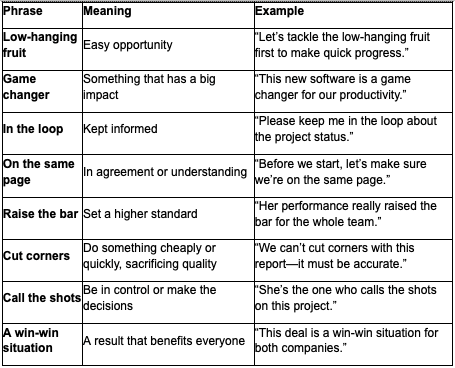When you start working in an English-speaking business environment, you may find that people often use words and expressions that aren’t taught in textbooks. These words are called business jargon and idioms. They are informal or figurative ways of speaking, and they can be confusing—even for native speakers!
As an ESL learner, understanding business jargon and idioms is important. It helps you communicate more naturally, understand meetings, and feel more confident in professional situations. In this article, we will explore what these terms mean, why they are used, and go through common examples with easy-to-understand explanations.
What is Business Jargon?
Business jargon refers to technical or trendy words and phrases used in the workplace. These are often used in specific industries or departments and might sound impressive but can be confusing if you don’t know what they mean.
Examples of Business Jargon:
-Leverage – Use something to your advantage.
“We need to leverage our partnerships to grow faster.”
-Synergy – When different departments or people work together and the result is better than working alone.
“There’s great synergy between marketing and sales.”
-Touch base – Contact someone to check in or discuss something.
“Let’s touch base next week to go over the proposal.”
-Bandwidth – Time or mental capacity to handle more work.
“I don’t have the bandwidth to take on another project right now.”
-Circle back – Return to a topic later.
“Let’s circle back to this issue after lunch.”
These phrases may sound strange at first, but they are commonly used in emails, meetings, and presentations.
What is a Business Idiom?
An idiom is a phrase where the meaning is different from the literal definition of the words. For example, “break the ice” doesn’t mean physically breaking ice—it means starting a conversation in a friendly way.
Common Business Idioms:
-Break the ice – Start a conversation in a relaxed way.
“The manager told a joke to break the ice at the meeting.”
-Think outside the box – Be creative and look for new ideas.
“We need to think outside the box to solve this problem.”
-Get the ball rolling – Start a process or activity.
“Let’s get the ball rolling on this project today.”
-Back to the drawing board – Start again because the first attempt failed.
“The client didn’t like the design, so it’s back to the drawing board.”
-Hit the ground running – Start working quickly and effectively.
“We need someone who can hit the ground running in this role.”
These idioms help make speech more colorful and natural, but they require practice and context to understand properly.
Why Are Jargon and Idioms Used in Business?
Many professionals use jargon and idioms to:
-Sound professional or modern
-Save time with common phrases
-Create team identity or bonding
-Add humor or style to communication
However, too much jargon can be confusing, even for native speakers. That’s why it’s okay to ask questions or request clarification if you’re unsure.
Tips for ESL Learners to Understand and Use Business Jargon and Idioms
1. Listen and Read Regularly
Watch business videos (like TED Talks), attend meetings, or listen to podcasts in English. Read business blogs, news, or LinkedIn posts. These materials often use natural, real-world language.
2. Keep a Business Idioms Journal
Every time you hear or read a new phrase, write it down. Note the meaning, context, and an example sentence. Review the list regularly.
3. Ask for Clarification
If a colleague says something you don’t understand, don’t be afraid to ask:
- “Sorry, what does ‘circle back’ mean?”
- “Can you explain what you meant by ‘low-hanging fruit’?”
Most people are happy to explain.
4. Practice Using Them
Try to include one or two new idioms in your next email, meeting, or conversation. Start small, and soon they will become natural.
5. Learn in Context
Idioms often depend on tone or situation. Watching videos or reading stories that include business conversations will help you understand when and how to use them.
More Business Jargon and Idioms to Know

What to Avoid
While it’s useful to understand jargon and idioms, be careful not to:
-Overuse them – Too many can sound unnatural or forced.
-Use them without understanding – Always know the meaning before using.
-Use them in formal writing – Avoid in formal reports or legal documents unless it’s a quote or part of speech.
Understanding business jargon and idioms is an important skill for ESL learners who want to succeed in English-speaking workplaces. These expressions help you connect with colleagues, follow meetings, and express yourself more naturally.
Don’t worry if they seem confusing at first—like any part of language, they become easier with time and practice. Start small, keep a journal, ask questions, and slowly incorporate these phrases into your business English conversations.
Remember, learning business English isn’t just about grammar and vocabulary—it’s also about understanding the culture, tone, and expressions used every day in the workplace.
Ready to “get the ball rolling”? Start by choosing three idioms from this article and try using them in your next conversation or email!







